Disclosure: We may earn commissions if you purchase products after clicking on a link from our site.
Do you always relish catching swordfish? Would you like to know how to catch swordfish? Swordfish are one of the fiercest predators any angler will experience when fishing. They are large, powerful, fast, agile, and will put up a serious fight for a long period when hooked.
Many anglers have to catch on their fishing wish list. In this article, we will share information about how to catch swordfish the best baits, lures, fishing gear, swordfish fishing tips, and other information to help you achieve this fishing feat of landing a swordfish.
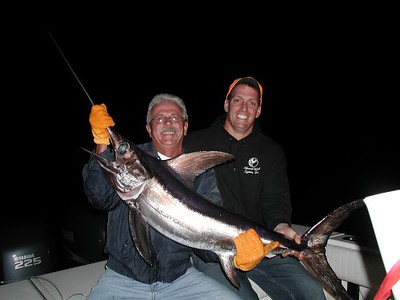
Table of Contents
How To Catch Swordfish
How to catch swordfish during the day depends on the angler and the conditions during the day. Many different fishing methods can be used for fishing swordfish and they are explained below.
1. Trolling
Trolling is another effective method for catching swordfish, particularly in offshore environments. Anglers deploy specialized trolling rigs equipped with artificial lures or natural baits at various depths behind the boat while cruising at slow speeds.
Swordfish are known to patrol the waters at different depths, making trolling a versatile approach for targeting them. Anglers often use electronic equipment such as sonar and depth finders to locate swordfish and adjust trolling depths accordingly.
Once a swordfish strikes, anglers must quickly reel in the fish and secure it using appropriate gear. Trolling allows anglers to cover large areas of water and increase their chances of encountering swordfish. To learn more about trolling techniques for swordfish fishing, consult resources provided by NOAA Fisheries.
2. Drifting With Live Bait
Drifting with live bait is a widely practiced method for targeting swordfish, particularly in areas where these apex predators are known to congregate. Anglers rig live baitfish such as mackerel or squid on specialized rigs and deploy them while drifting with the current or wind.
Swordfish are attracted to the natural movement and scent of live bait, making this method highly effective. Anglers must maintain proper bait presentation and monitor their drift to maximize their chances of enticing swordfish strikes.
Once a swordfish takes the bait, anglers must swiftly set the hook and engage in a battle to land the fish. Drifting with live bait requires patience and attentiveness but can yield impressive results when targeting swordfish. For more information on drifting techniques in swordfish fishing, refer to resources provided by NOAA Fisheries.
3. Kite Fishing
Kite fishing is a fishing method in which a kite is used to suspend the bait at different depths in the water. It is effective in attracting swordfish located at different depths in the water column. It helps you cover a large area of the water when fishing for swordfish in a relatively short period of time.
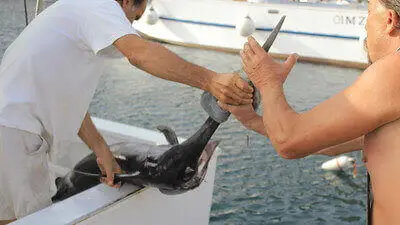
4. Deep Dropping
Deep dropping is a popular method used to catch swordfish, especially in deeper offshore waters. Anglers deploy specialized rigs equipped with heavy sinkers and baited hooks to target swordfish at considerable depths.
Typically, the bait is lowered to depths of several hundred feet or more, where swordfish are known to dwell. This method requires precise boat positioning and the use of electronic equipment to locate swordfish and monitor bait presentation.
Once a bite is detected, anglers must reel in the fish from significant depths, making deep dropping a challenging but rewarding technique for catching swordfish. For more information on deep dropping and its application in swordfish fishing, visit NOAA Fisheries.
When deep dropping, you must be ready to strike when the swordfish takes the bait. A good fish finder will provide that information. if you are interested in the best fish finders, then you can read this review.
Swordfish Tackle
Swordfish is a large, agile, fast, powerful, and elusive fish. It is also one of the fiercest of fish you will encounter. It will put up a serious fight when hooked. Therefore, you will need a sturdy fishing rod and reel with a high line capacity to its strength and weight.
Additionally, a 30-pound reel with 500 yds of the 80-pound braid with a 150 yd top shot of 60 mono and a wind-on leader and a strong drag system to handle the ferocious fight of the swordfish will work.
A breakaway rig works well when targeting swordfish as it allows for a quick release of the fishing line if it becomes entangled. A hook size of 12/0, a leader of about 300-500 pounds, and a drag pressure of a minimum of 30 pounds will work when targeting swordfish. A pair of gloves will work well when handling the bill of a swordfish.
Understanding Swordfish Behavior
To learn how to catch swordfish, you should learn the behavior of swordfish. This knowledge will give you an advantage on where to look for them during the day and the night, as well as when the temperature changes or the season changes.
Understanding their migratory patterns, which are influenced by food sources and water temperatures, will help effectively fish for swordfish. You will significantly improve your chances of finding swordfish by studying their movements.
Swordfish usually go to deeper waters during the winter season where they can prey on baitfish that reside in the deep scattering layer. This deep scattering layer is a layer of the ocean, usually at depths of 1,000 to 1,500 feet, where there are a lot of marine life activities happening. Swordfish will be there feeding on squid, baitfish, plankton, crustaceans, and other baits.
Where To Catch Swordfish
Swordfish can be found in the Atlantic, Pacific, and Indian Oceans, from California to the Gulf of Mexico, Australia, Venezuela, and the Mediterranean Ocean. However, to be more precise, look for areas where the water temperature, food supply, and structures for cover align.
Find the baitfish, and you will find swordfish. When the baitfish go to deeper water, swordfish will pursue the food supply by going deeper. When the baitfish come closer to them at night, swordfish will come closer to the surface.
Additionally, you can find structures like rock piles, seamounts, and ledges underwater where baitfish, squid, and other fish can try to seek cover from predators like swordfish, you will also find swordfish there hiding and setting ambush for the baitfish.
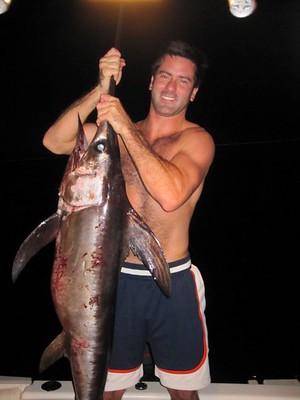
Best Bait For Swordfish
1. Squid
Squid is a highly effective bait choice for targeting swordfish due to its natural appearance and scent, making it enticing to these apex predators. Squid can be used fresh or frozen, with both options proving successful in attracting swordfish. Anglers typically rig squid on specialized bait rigs designed to present the bait at specific depths where swordfish are known to inhabit.
The squid’s soft texture and natural movement in the water mimic live prey, making it irresistible to swordfish. When rigging squid for swordfish, anglers often use techniques such as bridling or stitching to secure the bait to the hook securely.
Additionally, some anglers opt to rig multiple squids on a single line to increase the bait’s attractiveness and visibility in the water. Squid is a versatile bait option that can be deployed using various fishing methods, including deep dropping, trolling, and drifting with live bait. Its effectiveness in enticing swordfish strikes has made it a preferred choice among anglers targeting these elusive game fish.
2. Mackerel
Mackerel is a popular and effective bait choice for targeting swordfish, prized for its oily flesh and strong scent that can attract these deep-sea predators. When using mackerel as bait for swordfish, anglers often prefer fresh or frozen whole mackerel, although mackerel strips or chunks can also be effective.
The oily nature of mackerel releases scent and oils into the water, creating a potent attractant for swordfish even at significant depths. Anglers rig mackerel on specialized bait rigs, often with additional weight or lights to help sink the bait to the desired depth where swordfish are known to roam.
Depending on the fishing method employed, mackerel can be rigged whole, butterfly-style, or as fillets to maximize its presentation in the water. Whether deep dropping, trolling, or drifting, mackerel is versatile enough to be used effectively in various fishing scenarios. Its natural appeal and durability make it a preferred bait choice for anglers pursuing the elusive and powerful swordfish.
3. Bonito
Bonito, a member of the mackerel family, serves as an exceptional bait option for targeting swordfish due to its strong aroma and oily flesh. Swordfish are highly attracted to the scent and movement of bonito, making it a popular choice among anglers. Typically, bonito is used in chunks or strips, with the skin left intact to enhance its durability in the water.
Anglers often rig bonito on specialized swordfish rigs, sometimes incorporating additional attractants such as lights or reflective tape to increase visibility in deep waters. Bonito’s natural oils disperse into the water, creating a scent trail that can entice swordfish from considerable distances.
Whether fishing during the day or night, bonito remains effective at luring swordfish to the baited area. Its versatility allows anglers to deploy it using various methods such as deep dropping, drifting, or trolling. Overall, bonito serves as a reliable and enticing bait option for anglers seeking to hook into the prized and powerful swordfish.
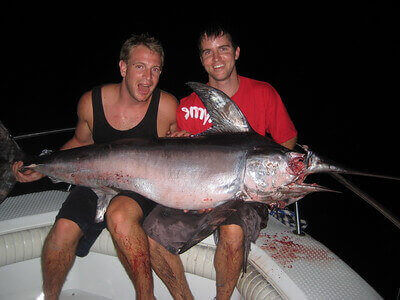
4. Herring
Herring is a popular bait choice for targeting swordfish due to its strong scent, oily texture, and natural swimming action. Anglers often use fresh or frozen herring, rigged whole or in chunks, to attract swordfish in deep offshore waters. The natural oils released by herring create a scent trail that can lure swordfish from great distances, making it effective for deep-dropping or drifting techniques.
Additionally, herring’s shiny scales and lifelike movement in the water make it an irresistible target for predatory swordfish. Anglers may rig herring on specialized swordfish rigs, often incorporating lights or reflective materials to increase visibility in the dark depths.
Whether fishing during the day or night, herring remains a reliable bait option for anglers targeting swordfish, offering both visual appeal and enticing scent to attract these powerful game fish.
5. Hake
Hake is not commonly used as bait for swordfish. Swordfish typically prey on a variety of fish species found in their habitat, including mackerel, herring, squid, and bonito, among others. While hake might attract some predatory fish, it lacks the oily texture and strong scent that make other bait options more effective for targeting swordfish.
Anglers typically opt for baitfish with higher oil content and stronger scent to create a more enticing lure for swordfish. Therefore, while hake may occasionally catch the attention of swordfish, it is not considered a preferred or widely used bait option for this particular species.
6. Sardines
Sardines are one of the most popular bait choices for targeting swordfish due to their oily flesh and strong scent, which effectively attract these apex predators. When rigged properly, sardines can entice swordfish to strike, making them a valuable bait option for anglers.
To use sardines as bait for swordfish, anglers typically rig them on a specialized swordfish rig, often incorporating lights or other attractants to enhance visibility in the deep ocean waters where swordfish reside. The scent trail and visual appeal of the sardine bait can lure swordfish from a distance, increasing the likelihood of a successful catch.
Additionally, sardines are readily available and relatively easy to handle, making them a convenient choice for anglers targeting swordfish. Overall, sardines are highly effective bait for swordfish fishing, contributing to their popularity among anglers pursuing these prized game fish.
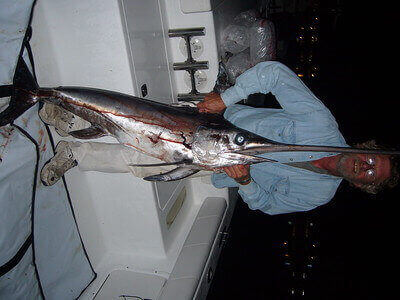
7. Anchovies
Anchovies are commonly used as bait for swordfish due to their oily and flavorful profile, making them attractive to these predatory fish. When rigged properly, anchovies can serve as an effective bait option for enticing swordfish to strike.
Anglers often rig anchovies on specialized swordfish rigs, which may include lights or other attractants to increase visibility in the deep waters where swordfish dwell.
The strong scent and natural oils released by anchovies create an enticing scent trail that can attract swordfish from a distance.
Additionally, anchovies are relatively easy to handle and are readily available in many regions, making them a convenient choice for anglers targeting swordfish. Overall, anchovies can be a valuable bait option for swordfish fishing, contributing to the success of anglers seeking to land these prized game fish.
Best Lures For Swordfish
1. Deep-Diving Plugs
Deep-diving plugs are a popular lure choice for targeting swordfish, particularly when fishing in deep offshore waters. These lures are designed to dive to significant depths, often reaching depths of 20 feet or more, where swordfish typically reside. Their streamlined shape and weighted bodies enable them to descend quickly to the desired depth, maximizing the time spent in the strike zone.
Deep-diving plugs are often equipped with rattles or other noise-making mechanisms to attract swordfish by producing vibrations and sound underwater. Anglers can deploy deep-diving plugs either by trolling from a moving boat or by drifting in the current, allowing the lures to cover a wide area and increase the chances of enticing a strike.
The lifelike appearance and action of these lures, combined with their ability to reach the depths where swordfish feed, make them effective tools for anglers targeting these elusive game fish. Overall, deep-diving plugs offer anglers a versatile and effective option for enticing swordfish and can significantly increase the chances of a successful catch.
2. Skirts
Skirts are a versatile and effective lure option for targeting swordfish, offering anglers a wide range of colors, sizes, and configurations to suit different fishing conditions. These lures consist of a skirted head, often made of lead or other weighted materials, paired with a series of silicone or rubber skirts that create lifelike movements in the water.
The skirts mimic the appearance of squid or small fish, which are prime prey for swordfish, making them highly attractive to these predatory species. Skirts can be rigged with hooks and deployed at various depths using downriggers, planers, or deep-drop rigs, allowing anglers to target swordfish at different depths in the water column.
Additionally, skirts can be combined with natural baits such as squid or mackerel to enhance their effectiveness and increase the chances of enticing a strike. Anglers often customize their skirts by adding scents or attractants to further entice swordfish. Whether deployed while trolling, drifting, or deep-dropping, skirts are a proven lure option for swordfish fishing, offering anglers a versatile and effective tool for targeting these prized game fish.

How To Catch Swordfish At Night
Many years ago, it was the consensus that swordfish could only be caught during the night, and daytime fishing for swordfish wasn’t possible. However, with more fishing technology available and more understanding of the behavior of swordfish, we learn that is not the case.
At night, swordfish come closer to the surface of the water to feed as the baitfish is closer to the surface during the night. You can easily find swordfish at just 300 ft during the night as they prey on baitfish.
During the day, the baitfish will descend to deeper depths like the deep scattering layer which makes swordfish also go to that depth in search of baitfish.
1. Trolling
Trolling can also be used to catch swordfish during the night. They are further up the water column in search of baitfish during the night and this may make it easier to target them.
2. Drifting
Drifting is also used to target swordfish during the night. You can drift at 350 feet over inshore humps and canyons. Use squid and other baits while drifting fishing at night. The current in the water at night will determine how you will drift.

Swordfish vs Marlin
| Feature / Characteristic | Swordfish | Marlin |
|---|---|---|
| Strength | Swordfish are stronger than marlin. | Not as strong as swordfish. |
| Bill | Larger than that of marlin. | Smaller bill. |
| Dorsal Fin | Non-retractable and taller than marlin’s fin. | Crest-shaped dorsal fin more streamlined to body. |
| Eyesight | Better eyesight than Marlin. | Not as good as swordfish’s. |
| Body Shape | Round elongated body. | Tubular smooth body. |
| Behavior | Migrates annually across the sea. | Migrates less than swordfish. |
| Appearance |
Silver and gray in appearance. |
Distinct blue top. |
| Size | Smaller than marlin. | Larger than swordfish. |
| Lifespan | Swordfish live for 10 years or less. | Marlin lives 10 to 20 years. |
| Taste | Flesh is fattier and thicker than marlin; has great taste. | Milder flavor than swordfish. |
| Where It Lives |
Lives further below the surface in the deep scattering layer (DSL) usually at depths of 1,000 – 1,500 ft. |
Lives in deep tropical oceans. |
Swordfish Fishing Tips
- If you are fishing for swordfish and are catching squid in an area, then you can be sure that swordfish is the area also preying on squid.
2. Swordfish put up a ferocious fight when hooked and they also have the endurance for a long and intense battle. Be physically and mentally prepared for the fight as the prize is well worth it.
3. Choosing the right gear for swordfish fish is very important to success as it is a large and powerful fish.
4. Use the right bait when fishing for swordfish. Squid, or strips of squid, is one of the most popular baits used by anglers when targeting swordfish. Others are mackerel, bonito, anchovies, herring, sardines, and hake.
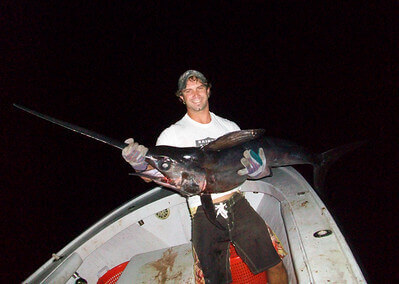
5. Monitor the temperature change when fishing for swordfish as their migratory patterns are influenced by the water temperature and food supply.
6. The depth of the water is also another factor to consider when targeting swordfish. They usually reside in deep water as they go after baitfish, squid, plankton, crustaceans, and other food sources in the deep scattering layer. However, they will come closer to the surface when their food supply moves to the surface.
7. Be patient when fishing for swordfish as it may take some time to locate them. Be observant and look for signs of swordfish activity such as jumping or finning.
8. If you are fishing for swordfish and you are finding squid, that is a sign that you are in the right area as swordfish will be preying on squid there also.
9. Bump trolling, deep dropping, drift fishing, and kite fishing are some of the fishing methods you can use when fishing for swordfish.

10. Look for structures, like ledges, rock piles, and seamounts, under the water that could provide cover for baitfish. Swordfish will be in that area hiding under the structures waiting to ambush baitfish.
11. Swordfish are usually found at the bottom during the day where they feed on baitfish, plankton, and other crustaceans. During the night, you can find them closer to the water’s surface as they go after baitfish that are at the surface of the water during the night.
How To Cook Swordfish
Swordfish is considered a delicacy and have a premium value because of its firm, white flesh that is low in fat and has a mild, sweet flavor. Swordfish can be prepared in a number of ways to bring out its tasty flavor by grilling, baking, or smoking.
The Bottom Line
Swordfish is one of the most elusive, powerful, fast, and agile fish sought after by anglers. It is the dream of almost all anglers to catch this behemoth of a fish. Catching a swordfish will definitely test your fishing skills, knowledge of it, test your bait presentation skills, strategy, and patience.
In this article, we discussed how to catch swordfish as well as the fishing methods, the right gear to catch swordfish, the baits and lures, fishing tips, and tricks. You can also read how to catch sailfish and how to catch marlin.